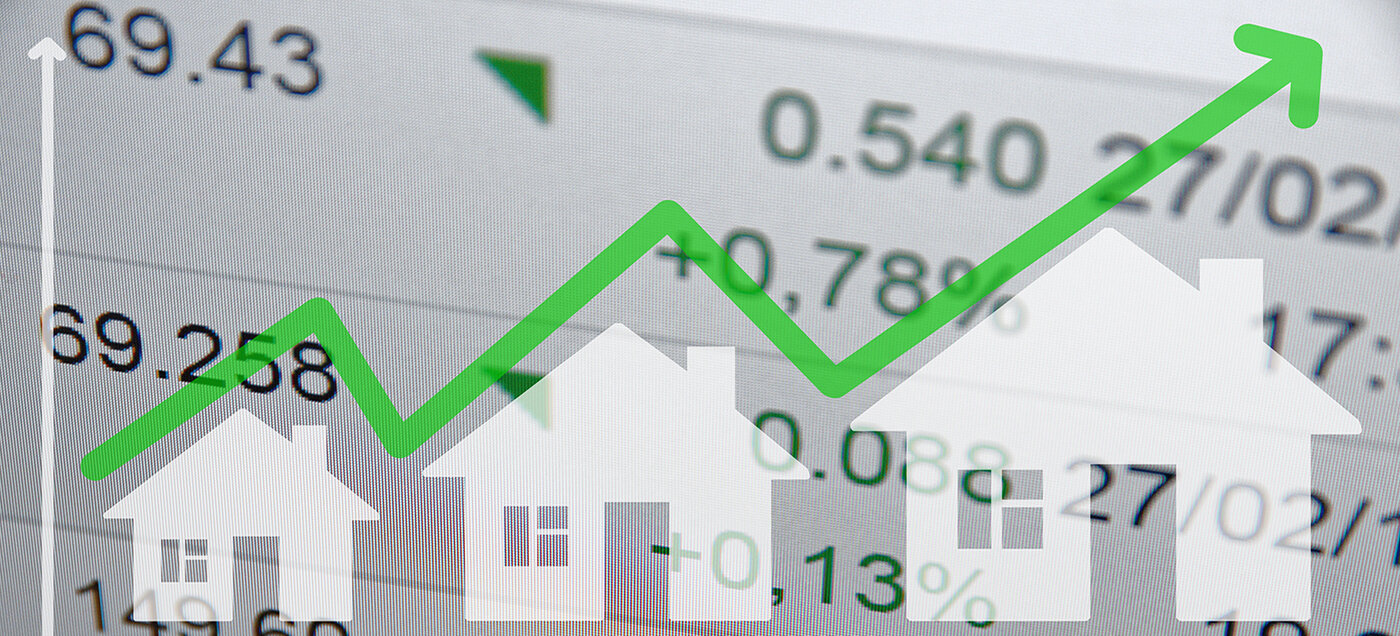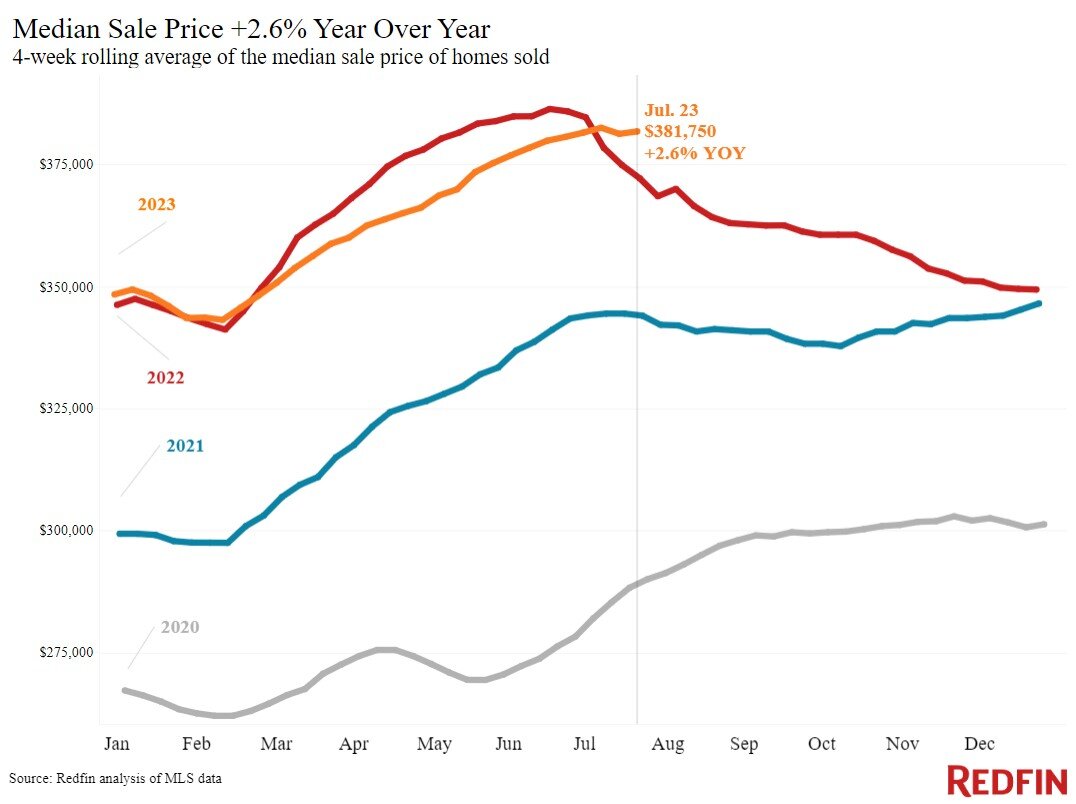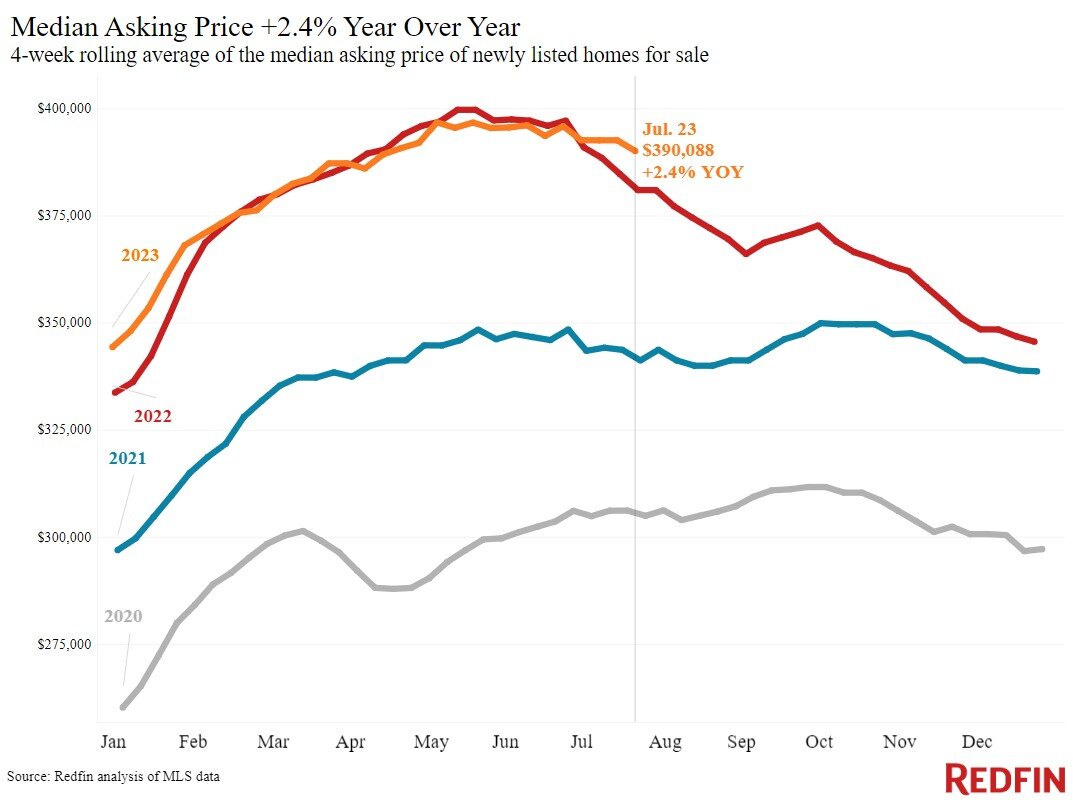Residential Real Estate News

U.S. Home Prices Uptick 3 Percent Annually in July
Residential News » Seattle Edition | By WPJ Staff | July 31, 2023 7:50 AM ET
Biggest annual home price increase since November 2022
According to national property broker Redfin, the typical U.S. home sold for roughly $382,000 during the last week of July 2023, up 2.6% from a year earlier, the biggest increase since November.
Still, homebuyers are getting a bit of relief as mortgage rates inch down from the eight-month high hit a few weeks ago. The typical monthly mortgage payment is $2,599 at today's average weekly rate, down $55 from the all-time high of $2,654 in early July.
Today's housing market is unusual because prices are increasing despite lukewarm demand. Redfin's Homebuyer Demand Index--a measure of requests for tours and other home buying services from Redfin agents--is down 3% from a year ago, and mortgage-purchase applications are down about 23%. But inventory has dropped more than demand, with homeowners hanging onto their comparatively low mortgage rates, which is sending prices up. New listings are down 22% from a year ago, and the total number of homes for sale is down 17%, the biggest decline in a year and a half. Pending sales are down 15%, partly because the lack of inventory is tying potential homebuyers' hands.
This week's news that the Fed is no longer forecasting a broad economic recession is hopeful for the housing market, despite the simultaneous interest-rate hike. The Fed indicated that a soft landing is more likely than they had previously thought, which would mean interest rates went high enough to tame inflation but not enough to cause a surge in unemployment and send the economy into a recession.
"This is hopeful news for the housing market in a few ways," said Redfin Economic Research Lead Chen Zhao. "Avoiding a recession means Americans will hold onto their jobs, for the most part, and feel more confident about purchasing big-ticket items like a house. Steady progress on taming inflation means that while mortgage rates will probably stay elevated for at least a few months, they're likely to start coming down before the end of the year. That should encourage some sellers and buyers to jump into the market."
Leading indicators of homebuying activity:
- The daily average 30-year fixed mortgage rate was 6.95% on July 26, up slightly from a week earlier. For the week ending July 20, the average 30-year fixed mortgage rate was 6.78%, down from a half-year high a week earlier.
- Mortgage-purchase applications during the week ending July 21 declined 3% from a week earlier, seasonally adjusted. Purchase applications were down 23% from a year earlier.
- The seasonally adjusted Redfin Homebuyer Demand Index was down 3% from a year earlier, the first decline after eight straight weeks of increases.
- Google searches for "homes for sale" were up essentially flat from a month earlier during the week ending July 22, and down about 6% from a year earlier.
- Touring activity as of July 23 was up 11% from the start of the year, compared with a 4% decrease at the same time last year, according to home tour technology company ShowingTime.
Key housing market takeaways for 400+ U.S. metro areas:
- The median home sale price was $381,750, up 2.6% from a year earlier. That's the biggest increase since November.
- Sale prices increased most in Miami (11.9% YoY), Milwaukee (9.3%), Cincinnati (8.9%), Anaheim, CA (8.3%) and West Palm Beach, FL (7.4%).
- Home-sale prices declined in 20 metros, with the biggest drops in Austin, TX (-8.8% YoY), Detroit (-6.4%), Phoenix (-4.7%), Las Vegas (-3.9%) and Sacramento (-3.8%).
- The median asking price of newly listed homes was $390,088, up 2.4% from a year earlier. That's the biggest increase since January.
- The monthly mortgage payment on the median-asking-price home was $2,599 at a 6.78% mortgage rate, the average for the week ending July 20. That's down about 2% from the record high hit two weeks earlier, but up 16% from a year earlier.
- Pending home sales were down 14.8% year over year, continuing a year-plus streak of double-digit declines.
- Pending home sales fell in all but two of the metros Redfin analyzed. They declined most in New Brunswick, NJ (-32.7% YoY), Newark, NJ (-32.1%), Providence, RI (-27.8%), Warren, MI (-27%) and Boston (-25.4%). They increased 2.7% in Las Vegas and 1.4% in Austin.
- New listings of homes for sale fell 21.6% year over year. That's a substantial decline, but the smallest in nearly three months.
- New listings declined in all metros Redfin analyzed. They fell most in Las Vegas (-45.2% YoY), Phoenix (-38.9%), Newark, NJ (-34.3%), Providence, RI (-32.9%) and New Brunswick, NJ (-31.7%).
- Active listings (the number of homes listed for sale at any point during the period) dropped 16.9% from a year earlier, the biggest drop since February 2022. Active listings were down slightly from a month earlier; typically, they post month-over-month increases at this time of year.
- Months of supply was 2.8 months, the highest level since March. Four to five months of supply is considered balanced, with a lower number indicating seller's market conditions.
- 43.9% of homes that went under contract had an accepted offer within the first two weeks on the market, on par with the share a year earlier.
- Homes that sold were on the market for a median of 27 days, up from 22 days a year earlier.
- 36.3% of homes sold above their final list price, down from 45% a year earlier.
- On average, 5.7% of homes for sale each week had a price drop, slightly below 6% a year earlier.
- The average sale-to-list price ratio was 100%. That's down from 101% a year earlier.
Sign Up Free | The WPJ Weekly Newsletter
Relevant real estate news.
Actionable market intelligence.
Right to your inbox every week.
Real Estate Listings Showcase
Related News Stories
Residential Real Estate Headlines
- U.S. New-Home Sales Surge in August as Mortgage Rates Ease
- Despite Increased Foreign Buyer Activity, Miami Residential Sales Dip 11 Percent in August
- California Home Sales Enjoy Modest Uptick as Mortgage Rates Ease
- U.S. Home-Flipping Profits Sink to Lowest Level Since 2008 Financial Crisis as Costs Climb
- Why the World's Rich Are Flocking to Europe in 2025
- Federal Reserve Delivers First Rate Cut of 2025 as Mortgage Relief Proves Limited
- Homebuilder Sentiment Holds Steady in U.S. as Rate-Cut Bets Lift Outlook
- U.S. Mortgage Rates Experience Sharpest Weekly Drop in Over a Year
- U.S. Foreclosures Rise for Sixth Straight Month as Affordability Pressures Mount
- Black U.S. Homeownership Rate Falls to Two-Year Low as Job Losses Mount
- Las Vegas Home Prices Flatten as Listings Surge, Sales Slow
- Cooling Miami Housing Market Sees 16 Percent Annual Sales Drop in July
- U.S. Mortgage Delinquencies Uptick in June Amid Regional Pressures
- California, Florida Top U.S. Housing Markets Most at Risk of Downturn
- 30-Year Mortgage Drops to 6.56 Percent in Late August, Lowest Since October 2024
- Investors Maintain Elevated Role in U.S. Housing Market Despite Slight Pullback
- Pending Home Sales Show Mixed Signals as U.S. Buyers Remain Cautious
- Canadian Home Sales Extend Recovery in July
- U.S. Home Sales Rise in July as Buyers Gain More Bargaining Power
- Zombie Foreclosures Edge Up Across U.S.
- 2.6 Million Homes at Wildfire Risk Across 14 Western States in 2025
- One in Five Americans Willing to Trade Personal Safety for Home Affordability
- U.S. Home Price Growth Slows as Affordability Pressures Mount in 2025
- U.S. Mortgage Rates Dip to Four Month Low in Early August
- U.S. Mortgage Applications Rise in Late July, Breaking Four-Week Slump
- Hong Kong's Housing Market Stuck in Stalemate as Bulls and Bears Face Off
- U.S. Condo Market Struggles in 2025
- U.S. Pending Home Sales Remain Sluggish in June
- Los Angeles Area Wildfires Destroyed Nearly $52 Billion in Homes Last January
- Greater Palm Beach Area Residential Sales Slip in June Amid Growing Inventory
- Economic Resilience Lifts U.S. Housing Outlook Going Forward
- New Home Sales Stagnate as Affordability Struggles Continue in America
- U.S. Housing Market Slips in June as Prices Hit New Highs
- Florida, California Continue to Reign Supreme as America's Ultraluxury Housing Markets
- Caribbean Housing Market Evolves into Global Second-Home Hotspot
- U.S. Home Sales See Highest June Cancellation Rate on Record
- Orlando Housing Market Cools in June as Listings Slide, Sales Slow
- Private Credit Surges in 2025 as Real Estate Developers Bypass Banks
- U.S. Condo Market Suffers Sharpest Price Drops in Over a Decade as Buyers Retreat
- Rising Taxes, Insurance Costs Undermine the Stability of U.S. Homeownership









